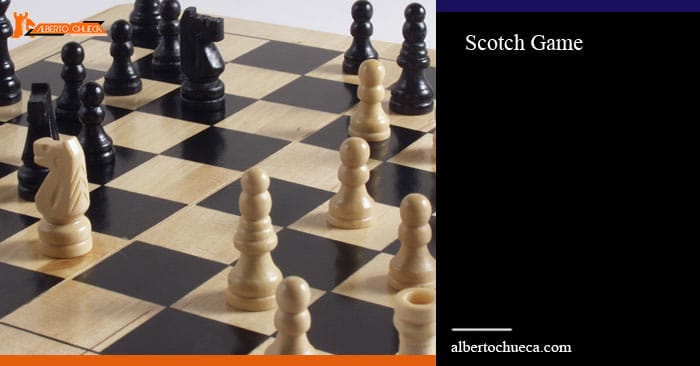Do you want to learn a new opening as White and escape out of the too well-known routine of Ruy Lopez or Italian Game? Then you are on the right site. In this post, we are going to study the dynamic and interesting Scotch Game with White pieces.
This variation was very popular in the 19th Century. However, the best players in the world stopped playing it after about 1900, because Black was getting good positions more or less easily. But this has changed in the last decades after Garry Kasparov started playing it and found some new interesting resources for White. Jan Timman was another strong master who helped to make Scotch Game much more playable for White.
Table of Contents
Some theory and ideas in Scotch Game
1e4 e5 2.Nf3 Nc6 3.d4
The idea with the 3rd move is to break the center and open the line for the dark squares Bishop. After the trade on d4, White will have removed Black’s central pawn, as they keep the King’s Pawn on e4, so we could say the first player will have some small advantage in the center in Scotch Game. Of course, Black can try to create some annoying threats on this center in the next moves as compensation.
- … exd4 4.Nxd4
This is the mainline, other options for White here are:
4.Bc4 Scotch Gambit
4.c3 Goring Gambit
A very common mistake among beginners and club players is to continue trading here: 4. … Nxd4? with the purpose of bringing white Queen out early in the game, which shouldn’t be fine for the first player according to the principles of the openings. However, this time Black cannot take advantage of the position of the Queen in the center (notice black Knight cannot go to c6 now, attacking and developing), and at the same time, this Queen is very annoying, because it is targeting g7 avoiding Black’s dark squares Bishop to be developed.
At this point in Scotch Game, Black can play two main lines:
- a) 4. … Bc5 Classical Variation
5.Be3 Qf6 6.c3 Nge7 7.Bc4 And the position is more or less balanced
- b) 4… Nf6 Schmidt Variation
5.Nxc6
Another interesting option for White here is 5.Nc3 (Scotch Four Knights) Bb4 6.Nxc6 bxc6 7.Bd3 d5 =
5… bxc6 6.e5 Qe7 7.Qe2 Nd5 8.c4 The position is unclear, but with chances for both players.
The opening theory is just starting at this point among the elite, but for beginners and club players this is fine up to here as the first steps with this line.
Typical Pawn Structures in Scotch Game
a) Classical Variation
White: a2 b2 c3 e4 f3 g2 h2
Black: a7 b7 c7 d6 f7 g7 h7
This structure appears frequently on this variation of Scotch Game. Both sides have a healthy pawn structure, although White has slightly better control in the center with the pawn on e4. That is the reason why Black should try to fight against this pawn in the middlegame, with moves like f5 or d5. If that happens, the first player can stay with a central isolated pawn after the exchange on e4, or just trade and accept they do not have a better center then. The right choice depends on the specific position on the board.
b) Schmidt Variation
White: a2 b2 c4 e5 f2 g2 h2
Black: a7 c6 c7 d7 f7 g7 h7
This is the most common structure on this line of Scotch Game. Black has doubled pawns on the “c” file, also an isolated pawn on a7, and three pawns islands. Therefore, White has a better pawn structure, although the pawn on e5 is very advanced and it could be strongly attacked in some lines. Also, the second player could try to use it as a “hook” to open some line and break in the center, with moves like f6 or d6.
Typical Plans in Scotch Game
a) Classical Variation
White should try to take advantage of better control in the center. Black will probably try to undermine this center, so probably there will be a trade and an isolated white pawn on e4. The first player can also try to exploit the position of some black pieces, like the Queen on g6, the Knight on e5, or the Bishop on b6.
b) Schmidt Variation
The middlegame will be a little strange. Both Queens are blocking the development of minor pieces, so both sides need to find a way to solve that problem. The black Knight on d5 in general at some point will retreat to b6 (in some line it could also go to b4). This Knight will stay a little out of play in that wing of the board, disconnected from other pieces, but still controlling and putting pressure in the center.
We could say White has a better pawn structure and more space in this line of Scotch Game, but in the end, Black can develop pieces and put a lot of pressure in the center and also exploit the weaknesses created by the advanced white pawns. Pawn moves like c5, d6, d5 or f6 are typical from Black.
Typical squares for white pieces in Scotch Game
King: White castles kingside almost always. There is a specific line in Schmidt Variation where white King moves to d1 and stays over the center, and also in some other lines White could castle Queenside, but this is not the most common.
Queen: It goes to e2 on Schmidt Variation, and probably e3 or e4 later so the light squares Bishop can be developed. It does not move until the middlegame in Classical.
Rooks: The “d” file is half-open since move 3, so, in general, that is an important file for White. Also, the “e” file is fine, protecting the advanced central pawn.
Bishops: In Schmidt Variation they are very often (although not always) developed over the Great Diagonals.
Knights: The Kingside Knight is traded since early in the opening in Schmidt Variation. It will probably stay on d4 in Classical. The Queenside Knight in general is developed over c3 (or sometimes d2) in Schmidt and over d2 in Classical (since there is a white pawn on c3).










